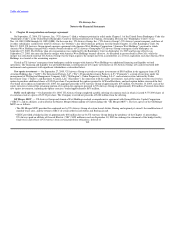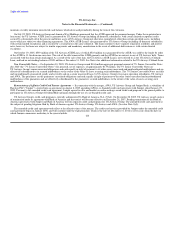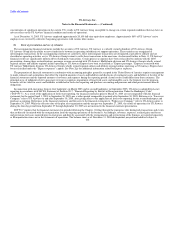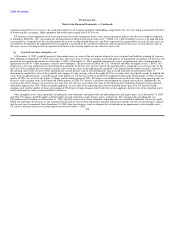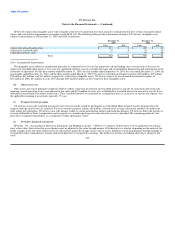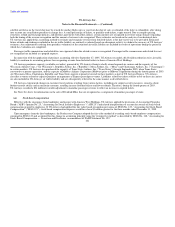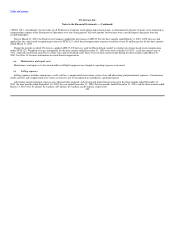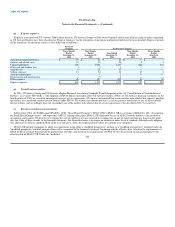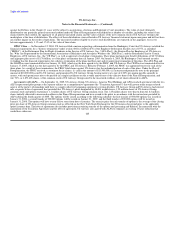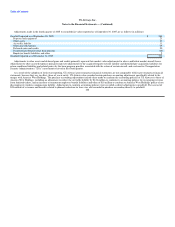US Airways 2005 Annual Report Download - page 227
Download and view the complete annual report
Please find page 227 of the 2005 US Airways annual report below. You can navigate through the pages in the report by either clicking on the pages listed below, or by using the keyword search tool below to find specific information within the annual report.
Table of Contents
US Airways, Inc.
Notes to the Financial Statements — (Continued)
sold but not flown on the travel date may be reused for another flight, up to a year from the date of sale, or refunded, if the ticket is refundable, after taking
into account any cancellation penalties or change fees. A small percentage of tickets, or partially used tickets, expire unused. Due to complex pricing
structures, refund and exchange policies, and interline agreements with other airlines, certain amounts are recognized in revenue using estimates regarding
both the timing of the revenue recognition and the amount of revenue to be recognized. These estimates are based on the analysis of our historical data.
US Airways has applied this accounting method to estimate and recognize revenue from forfeited tickets at the date travel was to be provided. Estimated
future refunds and exchanges included in the air traffic liability are routinely evaluated based on subsequent activity to validate the accuracy of US Airways'
estimates. Any adjustments resulting from periodic evaluations of the estimated air traffic liability are included in results of operations during the period in
which the evaluations are completed.
Passenger traffic commissions and related fees are expensed when the related revenue is recognized. Passenger traffic commissions and related fees not
yet recognized are included as a prepaid expense.
In connection with the application of purchase accounting effective September 27, 2005, US Airways recorded a $124 million reduction to its air traffic
liability to conform its accounting policies for recognizing revenue from forfeited tickets to those of America West Holdings.
US Airways purchases capacity (available seat miles) generated by US Airways Group's wholly owned regional air carriers and the capacity of Air
Wisconsin Airlines Corp., ("Air Wisconsin"), Republic Airline, Inc. ("Republic"), Mesa Airlines, Inc. ("Mesa") and Chautauqua Airlines, Inc. ("Chautauqua")
in certain markets. US Airways also purchased the capacity of Trans States Airlines, Inc. ("Trans States") through September 2005, when Trans States
converted to a prorate agreement, and the capacity of Midway Airlines Corporation (Midway) prior to Midway's liquidation during the fourth quarter of 2003.
Air Wisconsin, Mesa, Chautauqua, Republic and Trans States operate regional jet aircraft in these markets as part of US Airways Express. US Airways
classifies revenues related to capacity purchase arrangements as Express passenger revenues. Liabilities related to tickets sold for travel on these air carriers
are also included in US Airways' air traffic liability and are subsequently relieved in the same manner as described above.
US Airways experienced changes in customer travel patterns resulting from various factors, including new airport security measures, concerns about
further terrorist attacks and an uncertain economy, resulting in more forfeited tickets and fewer refunds. Therefore, during the fourth quarter of 2003,
US Airways recorded a $34 million favorable adjustment to mainline passenger revenue to reflect an increase in expired tickets.
See Note 2(i) above for information on the sale of Dividend Miles that are recognized as a component of mainline passenger revenue.
(m) Stock-based compensation
Effective with the emergence from bankruptcy and merger with America West Holdings, US Airways applied the provisions of Accounting Principles
Board ("APB") Opinion No. 25, "Accounting for Stock Issued to Employees" ("APB 25") and related interpretations to account for awards of stock-based
compensation granted to employees. If US Airways had applied the fair value based recognition provisions of SFAS No. 123, "Accounting for Stock-Based
Compensation" ("SFAS 123"), stock-based compensation expense would have been $1 million greater for the three months ended December 31, 2005.
Upon emergence from the first bankruptcy, the Predecessor Company adopted the fair value method of recording stock-based employee compensation
contained in SFAS 123 and accounted for this change in accounting principle using the "prospective method" as described by SFAS No. 148, "Accounting for
Stock-Based Compensation — Transition and Disclosure, an amendment of FASB Statement No. 123"
221



